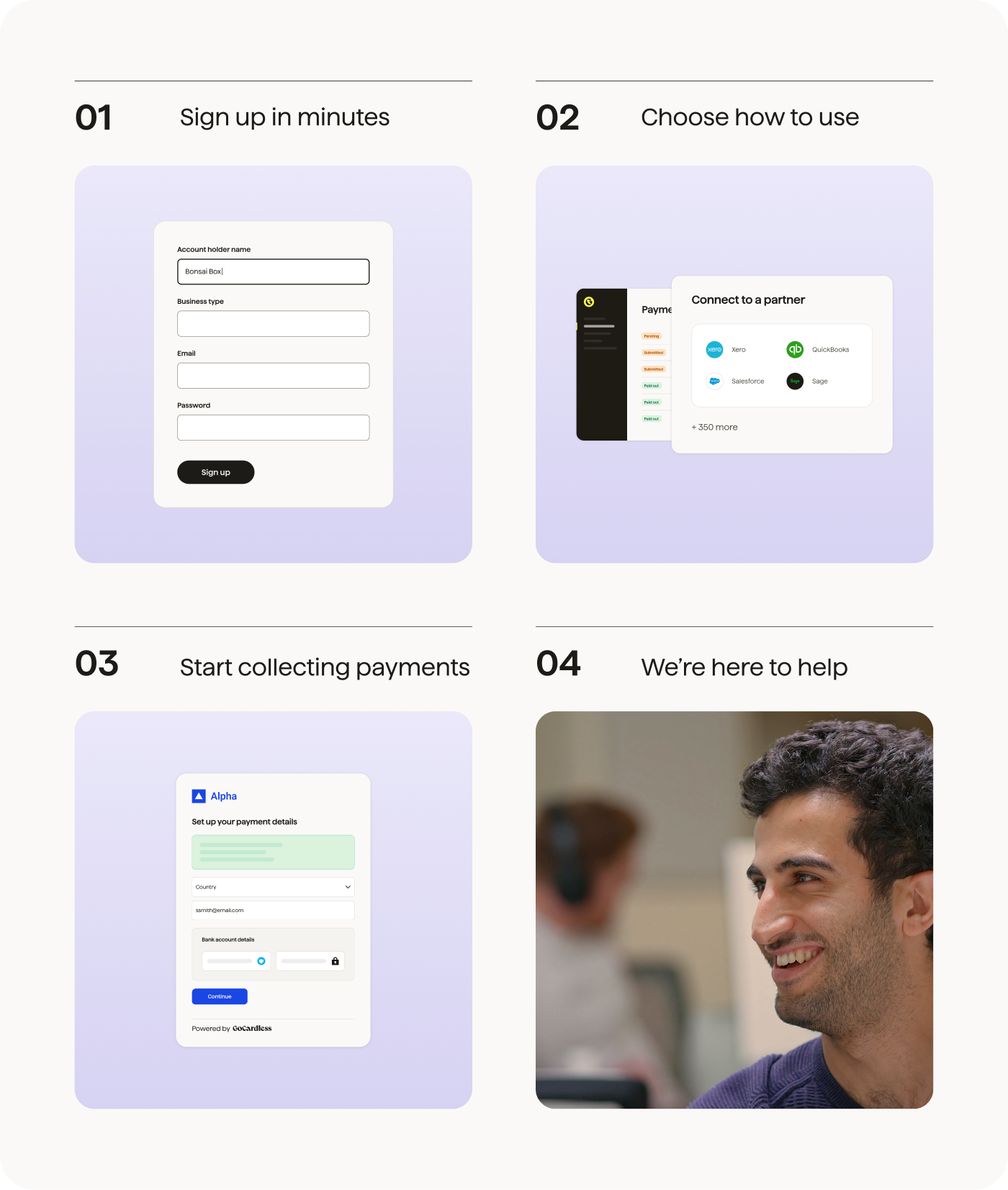
Last editedSep 20254 min read
SEPA Direct Debit is a Europe-wide Direct Debit system that allows merchants to collect Euro-denominated payments from accounts in the 36 SEPA countries and associated territories.
SEPA Direct Debit has now been implemented in all eurozone countries and non-eurozone SEPA countries. In these countries all Euro-denominated payments must be collected via the SEPA payment scheme.
This guide explains what SEPA is, and summarises the main features of the SEPA Direct Debit schemes from a merchant’s perspective to help you understand what it means for your business.
What is SEPA?
SEPA - the Single Euro Payments Area - is a European Union (EU) initiative to harmonise payments across the Eurozone. Its goal is to make European payments as easy and cheap as domestic ones by creating a single market for euro-denominated payments.
To achieve this, the European Payments Council (EPC) has created three SEPA payments schemes. Each scheme is a set of interbank “rules, practices and standards” that defines a payment instrument:
SEPA Direct Debit (SDD)
SEPA Cards Framework (SCF)
Key features of SEPA Direct Debit
SEPA Direct Debit is broadly similar to UK Direct Debit
SEPA Direct Debit is pull based. Once given a mandate by their customer it is the merchant who initiates payments.
SEPA Direct Debit payments are bank-to-bank. There are no card networks involved in the SEPA Direct Debit scheme. All communications happen directly between the banks.
However, SEPA Direct Debit differs from UK Direct Debit in five key ways:
1. Currency
All SEPA Direct Debit transactions happen in Euros (even if the relevant accounts aren't in Euros). Any currency exchange required is up to the payer's and merchant's banks.
2. Chargebacks
Payers can get a refund from their bank for unauthorised SEPA payments for up to 13 months. Under the UK Direct Debit Guarantee, the indemnity claim period is unlimited.
3. Bank details
To collect SEPA payments, you need a customer's BIC and IBAN rather than their account number and sort code.
4. Customers
Businesses and consumers can be treated differently (see SEPA Direct Debit refers to two schemes below).
5. Implementation
Several implementation details of SEPA Direct Debit differ from its UK counterpart including:
How to collect SEPA Direct Debit payments with GoCardless
1.
Create your free GoCardless account, access your user-friendly payments dashboard & connect your accounting software (if you use one).
2.
Easily set up & schedule SEPA Direct Debit payments via payment pages on your website checkout or secure payment links.
3.
From now on you'll get paid on time, every time, as GoCardless automatically collects payment on the scheduled Direct Debit collection date. Simple.
SEPA Direct Debit refers to two schemes
SEPA Direct Debit refers to two schemes: SEPA Core Direct Debit and SEPA B2B Direct Debit. In short, the B2B scheme is only available if you are collecting Direct Debit payments from other businesses.
The Core scheme is mandatory for all SEPA banks offering Euro-denominated Direct Debit. However, the B2B scheme is an optional scheme, meaning that not all banks are able to offer it.
When deciding on which scheme to adopt, the following should be considered to select the scheme that best suits your needs:
Customers – The SEPA B2B Direct Debit scheme can only be used for payers who are businesses - not private individuals or microenterprises. The Core scheme can be used with all payers.
Indemnity claim protections - SEPA B2B Direct Debit customers are not entitled to refunds of authorised transactions. Refunds for unauthorised transactions are only possible if the payer proves that he did not agree to a B2B mandate (up to 13 months after the debit date).
Timing - SEPA B2B Direct Debit offers a shorter timeline for payment submission (1 day before the collection) and a faster response time from the banks in case of technical failure or being unable to realise the collection (2 days after collection).
Throughout this guide references to SEPA Direct Debit are, unless explicitly stated, to both the Core and B2B schemes.
How will SEPA Direct Debit affect UK merchants?
The SEPA Direct Debit Scheme only affects Euro-denominated Direct Debit payments. Merchants collecting in GBP within the UK will continue to collect Direct Debit through the Bacs system as before. However, UK businesses collecting Euro-denominated payments from European customers will use the Euro Direct Debit scheme, SEPA.
The SEPA Payment scheme makes collecting Euro payments cheaper and easier. If you would like further information on SEPA payments and how to become compliant, you may find our guide to getting ready for SEPA helpful.
GoCardless makes collecting SEPA payments quick, easy and cost-effective for business owners - find more about how merchants collecting SEPA via GoCardless save time, money, and stress.

How to accept payments online
What is the best online payment option for your business? We've created a guide to help you decide and show you how to start collecting payments.
Use cases for SEPA Direct Debit
Collecting regular payments such as subscriptions. For companies collecting regular payments such as membership or subscription organisations, SEPA Direct Debit has three important advantages:
Control – Using SEPA Direct Debit enables merchants to ensure that customers will pay their bills on time every month.
Retention rates – Using SEPA Direct Debit eliminates failed payments due to card expiry or cancellation. It also increases customer loyalty by offering a convenient “set it and forget it” payment method.
Reduced admin – Using SEPA Direct Debit reduces the admin time involved in chasing and inputting updates to card details.
Invoicing for services where instant payment is not required. An example would be marketing agencies or accountancy firms. SEPA Direct Debit is great for B2B invoicing for three important reasons:
Improved cash flow – Using SEPA Direct Debit puts control back into the merchant’s hands. Merchants are able to collect payments when they want. This provides greater control over cash flow.
Variable amounts can be easily collected – Using SEPA Direct Debit enables merchants to collect variable amounts using a single upfront authorisation. As and when the payment amount changes, merchants are able to automatically claim the new amount. This differs from a standing order where customers need to give their bank new instructions each time a change is needed.
Reduced admin and credit chasing – Using SEPA Direct Debit reduces the time and manual effort required by chasing late payments and reconciling payments. It also reduces average debtor days without requiring awkward conversations about money with customers.
Account customers with an on-going relationship with the merchant. A good example would be wholesalers. Using SEPA Direct Debit to collect payments from account, or on-going customers works well for the same reasons as invoices (above). It also provides two additional key benefits to your customers:
Simple payment method for customers – It automates the collection process and enables customers to simplify the way they pay.
Allows a flexible payment option – SEPA Direct Debit allows ongoing customers the option of spreading costs and paying on account.
Markets with low card use such as Germany and the Netherlands, where credit card penetration is lower than 50%. Paying by bank account through SEPA Direct Debit is the preferred way to pay in these countries. Similarly, in industries or markets where usage of corporate cards is low, B2B customers will prefer to pay by bank account.
Collecting payments from European customers can be complicated and expensive!
That’s why GoCardless makes it simple, affordable and hassle-free for merchants to collect SEPA payments.
SEPA Direct Debit isn't so good for...
Transactions which need immediate clearing. SEPA Direct Debit payments are not instant, even under the faster B2B scheme - see our guide to timings for more information.
Transactions that are likely to be charged back, including liquid assets and high value goods. The SEPA Core Direct Debit no-questions-asked refund policy makes chargebacks easy in the initial eight weeks following the payment. This is a lower risk than with UK Direct Debit where chargeback periods were subject to no time limits.
SEPA Direct Debit and GoCardless
GoCardless is an online Direct Debit specialist that manages the entire SEPA Direct Debit collection process on your behalf. Merchants can collect and manage their payments through our REST API, an online dashboard, or by connecting GoCardless to a partner integration.
For a full list of countries you can collect SEPA Direct Debit payments from using GoCardless, visit our support centre.


